Civil Engineering Literature Review for Sustainable Future
VerifiedAdded on 2023/05/28
|13
|3336
|61
Report
AI Summary
This report presents a comprehensive literature review of key topics in civil engineering. It explores the crucial role of young civil engineers in sustainable development, examining their awareness and attitudes. The review delves into the effects of UV radiation and water spraying on the mechanical properties of flax fabric polymer composites, highlighting their potential in civil engineering applications. It also discusses the development and application of fiber-reinforced polymer (FRP) composites, emphasizing their benefits over conventional materials. Furthermore, the report addresses solving civil engineering problems using fuzzy and stochastic MCDM methods, the involvement of green materials in construction, and the application of structural health monitoring systems. The review also touches upon the difficulties faced in civil and structural engineering, and the use of fabricated plate grinders. The report examines decision-making methods and the importance of sustainability in civil engineering, providing a well-rounded overview of current research and advancements in the field.

Running head: CIVIL ENGINEERING
CIVIL ENGINEERING
Name of the Student
Name of the University
Author note
CIVIL ENGINEERING
Name of the Student
Name of the University
Author note
Paraphrase This Document
Need a fresh take? Get an instant paraphrase of this document with our AI Paraphraser
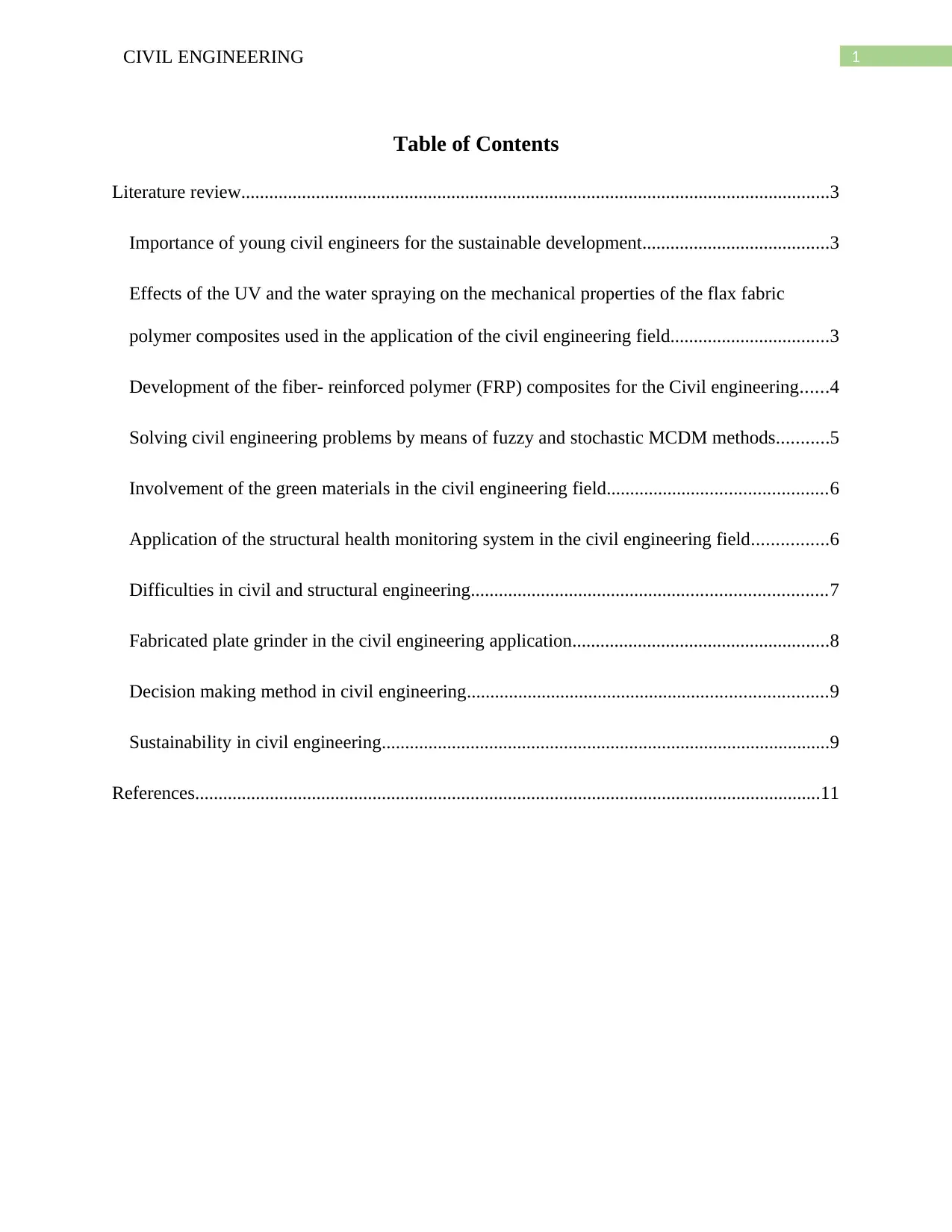
1CIVIL ENGINEERING
Table of Contents
Literature review..............................................................................................................................3
Importance of young civil engineers for the sustainable development........................................3
Effects of the UV and the water spraying on the mechanical properties of the flax fabric
polymer composites used in the application of the civil engineering field..................................3
Development of the fiber- reinforced polymer (FRP) composites for the Civil engineering......4
Solving civil engineering problems by means of fuzzy and stochastic MCDM methods...........5
Involvement of the green materials in the civil engineering field...............................................6
Application of the structural health monitoring system in the civil engineering field................6
Difficulties in civil and structural engineering............................................................................7
Fabricated plate grinder in the civil engineering application.......................................................8
Decision making method in civil engineering.............................................................................9
Sustainability in civil engineering................................................................................................9
References......................................................................................................................................11
Table of Contents
Literature review..............................................................................................................................3
Importance of young civil engineers for the sustainable development........................................3
Effects of the UV and the water spraying on the mechanical properties of the flax fabric
polymer composites used in the application of the civil engineering field..................................3
Development of the fiber- reinforced polymer (FRP) composites for the Civil engineering......4
Solving civil engineering problems by means of fuzzy and stochastic MCDM methods...........5
Involvement of the green materials in the civil engineering field...............................................6
Application of the structural health monitoring system in the civil engineering field................6
Difficulties in civil and structural engineering............................................................................7
Fabricated plate grinder in the civil engineering application.......................................................8
Decision making method in civil engineering.............................................................................9
Sustainability in civil engineering................................................................................................9
References......................................................................................................................................11
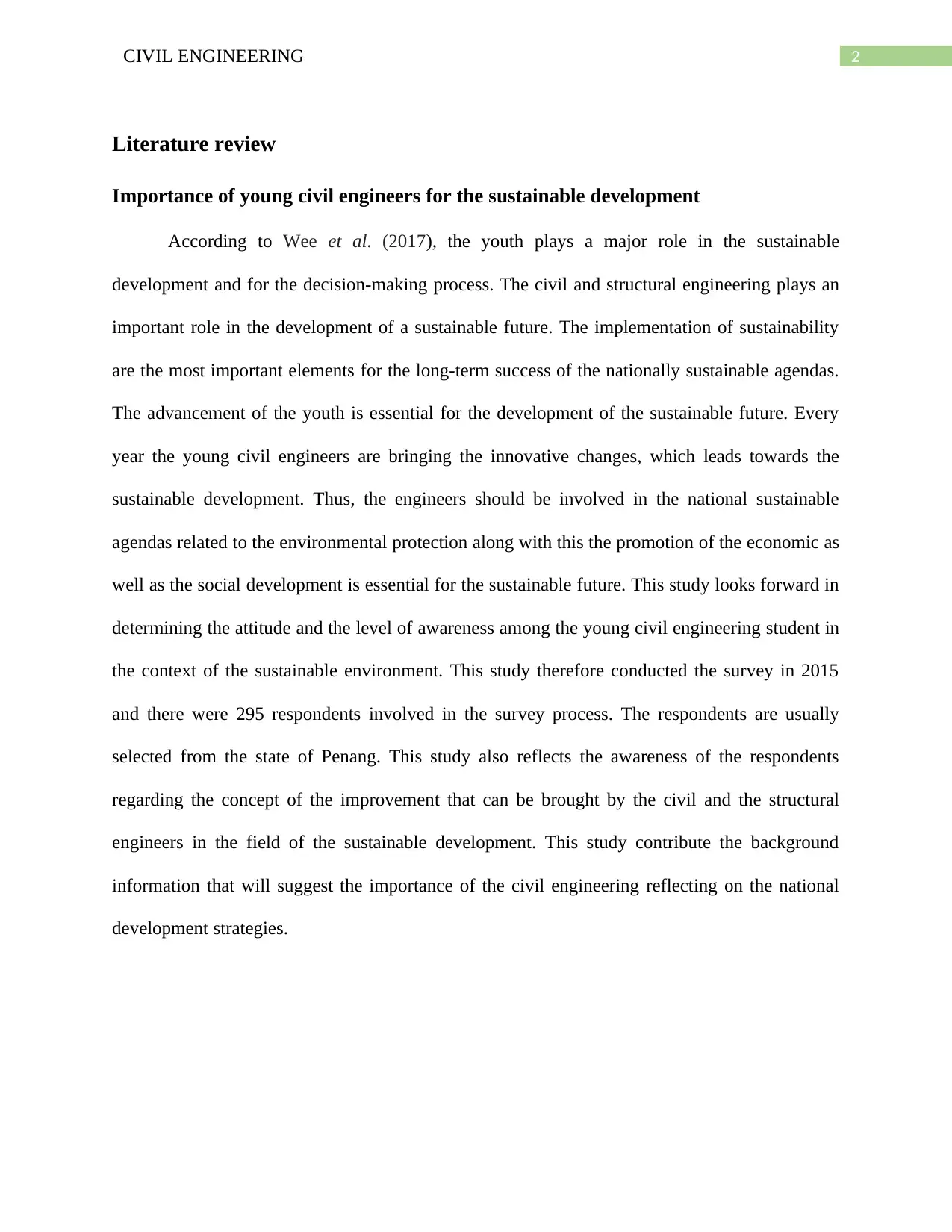
2CIVIL ENGINEERING
Literature review
Importance of young civil engineers for the sustainable development
According to Wee et al. (2017), the youth plays a major role in the sustainable
development and for the decision-making process. The civil and structural engineering plays an
important role in the development of a sustainable future. The implementation of sustainability
are the most important elements for the long-term success of the nationally sustainable agendas.
The advancement of the youth is essential for the development of the sustainable future. Every
year the young civil engineers are bringing the innovative changes, which leads towards the
sustainable development. Thus, the engineers should be involved in the national sustainable
agendas related to the environmental protection along with this the promotion of the economic as
well as the social development is essential for the sustainable future. This study looks forward in
determining the attitude and the level of awareness among the young civil engineering student in
the context of the sustainable environment. This study therefore conducted the survey in 2015
and there were 295 respondents involved in the survey process. The respondents are usually
selected from the state of Penang. This study also reflects the awareness of the respondents
regarding the concept of the improvement that can be brought by the civil and the structural
engineers in the field of the sustainable development. This study contribute the background
information that will suggest the importance of the civil engineering reflecting on the national
development strategies.
Literature review
Importance of young civil engineers for the sustainable development
According to Wee et al. (2017), the youth plays a major role in the sustainable
development and for the decision-making process. The civil and structural engineering plays an
important role in the development of a sustainable future. The implementation of sustainability
are the most important elements for the long-term success of the nationally sustainable agendas.
The advancement of the youth is essential for the development of the sustainable future. Every
year the young civil engineers are bringing the innovative changes, which leads towards the
sustainable development. Thus, the engineers should be involved in the national sustainable
agendas related to the environmental protection along with this the promotion of the economic as
well as the social development is essential for the sustainable future. This study looks forward in
determining the attitude and the level of awareness among the young civil engineering student in
the context of the sustainable environment. This study therefore conducted the survey in 2015
and there were 295 respondents involved in the survey process. The respondents are usually
selected from the state of Penang. This study also reflects the awareness of the respondents
regarding the concept of the improvement that can be brought by the civil and the structural
engineers in the field of the sustainable development. This study contribute the background
information that will suggest the importance of the civil engineering reflecting on the national
development strategies.
⊘ This is a preview!⊘
Do you want full access?
Subscribe today to unlock all pages.

Trusted by 1+ million students worldwide

3CIVIL ENGINEERING
Effects of the UV and the water spraying on the mechanical properties of the flax
fabric polymer composites used in the application of the civil engineering field
In accordance with Yan, Chouw and Jayaraman (2015), this study mainly looks after the
effects of the UV weathering degraded the mechanical properties of the flax or the epoxy
composites that are used in the civil engineering application. This study also highlights the SEM
confirmed degradation in the fibre or the matrix interfacial bonding. This study also contribute
information related to the concept of the effect of the UV weathering that is it causes the
discolouration, microcracking and matrix erosion. This study investigates the combined effect of
the UV radiation and the water spraying on the mechanical properties of the flax fabric
reinforced epoxy composites for accessing the durability performance of the composite, that are
used for the civil engineering applications. The hand lay-up process that were exposed in the
accelerated weathering chamber for the 1500 h fabricates the Specimens. This study researches
by the tensile and three-point bonding tests that were performed for evaluating the mechanical
properties. The Scanning electron microscope (SEM) are used to examine the microstructures of
the composites. In addition to this, the durability performance of the epoxy composites that are
compared with the synthetic and the hybrid fibre reinforced composites. The tensile results
showed that the tensile strength of the weathered composites rea decreased by the 29.9% and
34.9% respectively. The flexural strengths are reduced by 10.0% and 10.2% respectively and the
SEM study confirmed the degradations in the fibre interfacial bonding after the exposure. The
comparisons with the other composites also implies that the flax fabric composites has the
potentials of being used for the applications of the civil engineering field while taking the
structural and the durability performance into the account. This study find out that the proper
Effects of the UV and the water spraying on the mechanical properties of the flax
fabric polymer composites used in the application of the civil engineering field
In accordance with Yan, Chouw and Jayaraman (2015), this study mainly looks after the
effects of the UV weathering degraded the mechanical properties of the flax or the epoxy
composites that are used in the civil engineering application. This study also highlights the SEM
confirmed degradation in the fibre or the matrix interfacial bonding. This study also contribute
information related to the concept of the effect of the UV weathering that is it causes the
discolouration, microcracking and matrix erosion. This study investigates the combined effect of
the UV radiation and the water spraying on the mechanical properties of the flax fabric
reinforced epoxy composites for accessing the durability performance of the composite, that are
used for the civil engineering applications. The hand lay-up process that were exposed in the
accelerated weathering chamber for the 1500 h fabricates the Specimens. This study researches
by the tensile and three-point bonding tests that were performed for evaluating the mechanical
properties. The Scanning electron microscope (SEM) are used to examine the microstructures of
the composites. In addition to this, the durability performance of the epoxy composites that are
compared with the synthetic and the hybrid fibre reinforced composites. The tensile results
showed that the tensile strength of the weathered composites rea decreased by the 29.9% and
34.9% respectively. The flexural strengths are reduced by 10.0% and 10.2% respectively and the
SEM study confirmed the degradations in the fibre interfacial bonding after the exposure. The
comparisons with the other composites also implies that the flax fabric composites has the
potentials of being used for the applications of the civil engineering field while taking the
structural and the durability performance into the account. This study find out that the proper
Paraphrase This Document
Need a fresh take? Get an instant paraphrase of this document with our AI Paraphraser
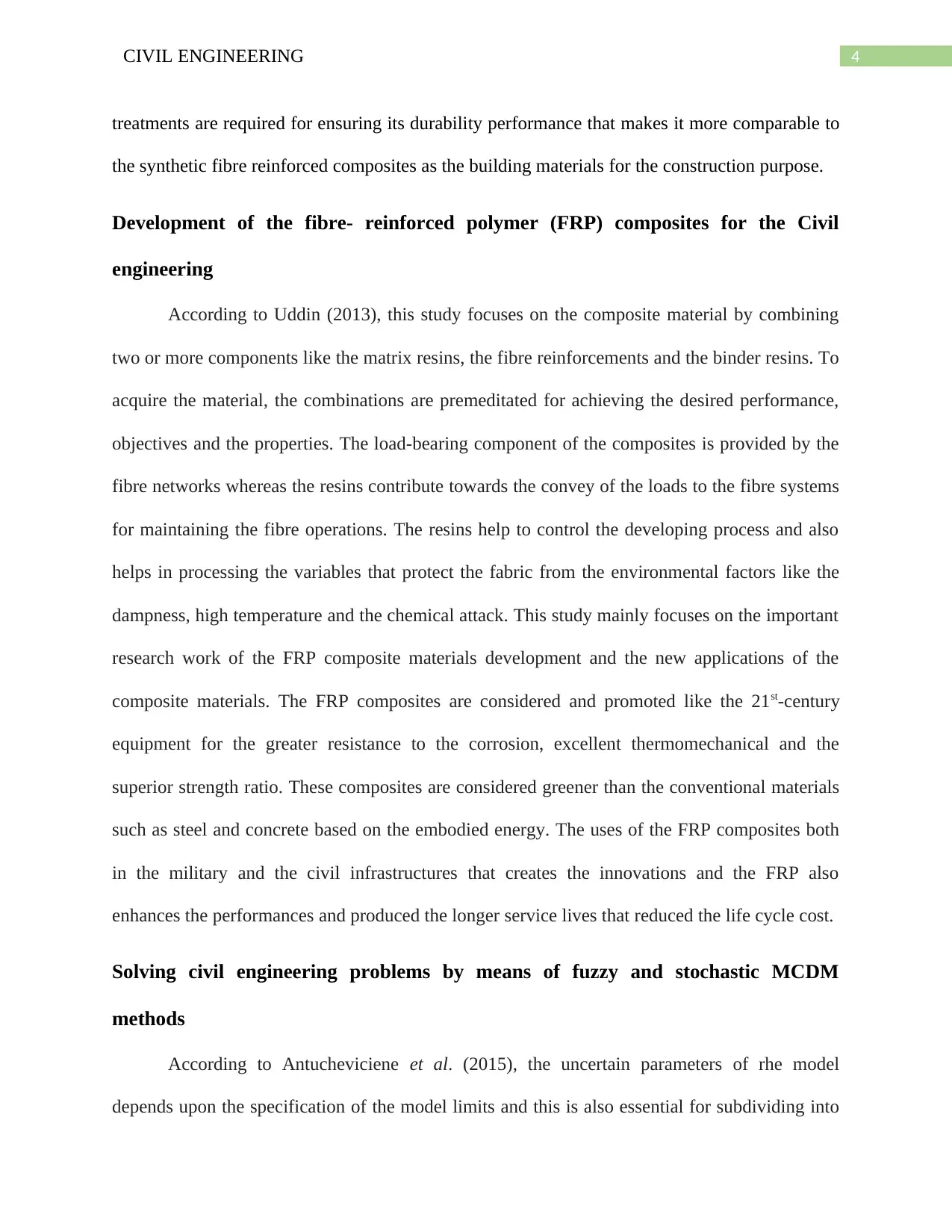
4CIVIL ENGINEERING
treatments are required for ensuring its durability performance that makes it more comparable to
the synthetic fibre reinforced composites as the building materials for the construction purpose.
Development of the fibre- reinforced polymer (FRP) composites for the Civil
engineering
According to Uddin (2013), this study focuses on the composite material by combining
two or more components like the matrix resins, the fibre reinforcements and the binder resins. To
acquire the material, the combinations are premeditated for achieving the desired performance,
objectives and the properties. The load-bearing component of the composites is provided by the
fibre networks whereas the resins contribute towards the convey of the loads to the fibre systems
for maintaining the fibre operations. The resins help to control the developing process and also
helps in processing the variables that protect the fabric from the environmental factors like the
dampness, high temperature and the chemical attack. This study mainly focuses on the important
research work of the FRP composite materials development and the new applications of the
composite materials. The FRP composites are considered and promoted like the 21st-century
equipment for the greater resistance to the corrosion, excellent thermomechanical and the
superior strength ratio. These composites are considered greener than the conventional materials
such as steel and concrete based on the embodied energy. The uses of the FRP composites both
in the military and the civil infrastructures that creates the innovations and the FRP also
enhances the performances and produced the longer service lives that reduced the life cycle cost.
Solving civil engineering problems by means of fuzzy and stochastic MCDM
methods
According to Antucheviciene et al. (2015), the uncertain parameters of rhe model
depends upon the specification of the model limits and this is also essential for subdividing into
treatments are required for ensuring its durability performance that makes it more comparable to
the synthetic fibre reinforced composites as the building materials for the construction purpose.
Development of the fibre- reinforced polymer (FRP) composites for the Civil
engineering
According to Uddin (2013), this study focuses on the composite material by combining
two or more components like the matrix resins, the fibre reinforcements and the binder resins. To
acquire the material, the combinations are premeditated for achieving the desired performance,
objectives and the properties. The load-bearing component of the composites is provided by the
fibre networks whereas the resins contribute towards the convey of the loads to the fibre systems
for maintaining the fibre operations. The resins help to control the developing process and also
helps in processing the variables that protect the fabric from the environmental factors like the
dampness, high temperature and the chemical attack. This study mainly focuses on the important
research work of the FRP composite materials development and the new applications of the
composite materials. The FRP composites are considered and promoted like the 21st-century
equipment for the greater resistance to the corrosion, excellent thermomechanical and the
superior strength ratio. These composites are considered greener than the conventional materials
such as steel and concrete based on the embodied energy. The uses of the FRP composites both
in the military and the civil infrastructures that creates the innovations and the FRP also
enhances the performances and produced the longer service lives that reduced the life cycle cost.
Solving civil engineering problems by means of fuzzy and stochastic MCDM
methods
According to Antucheviciene et al. (2015), the uncertain parameters of rhe model
depends upon the specification of the model limits and this is also essential for subdividing into
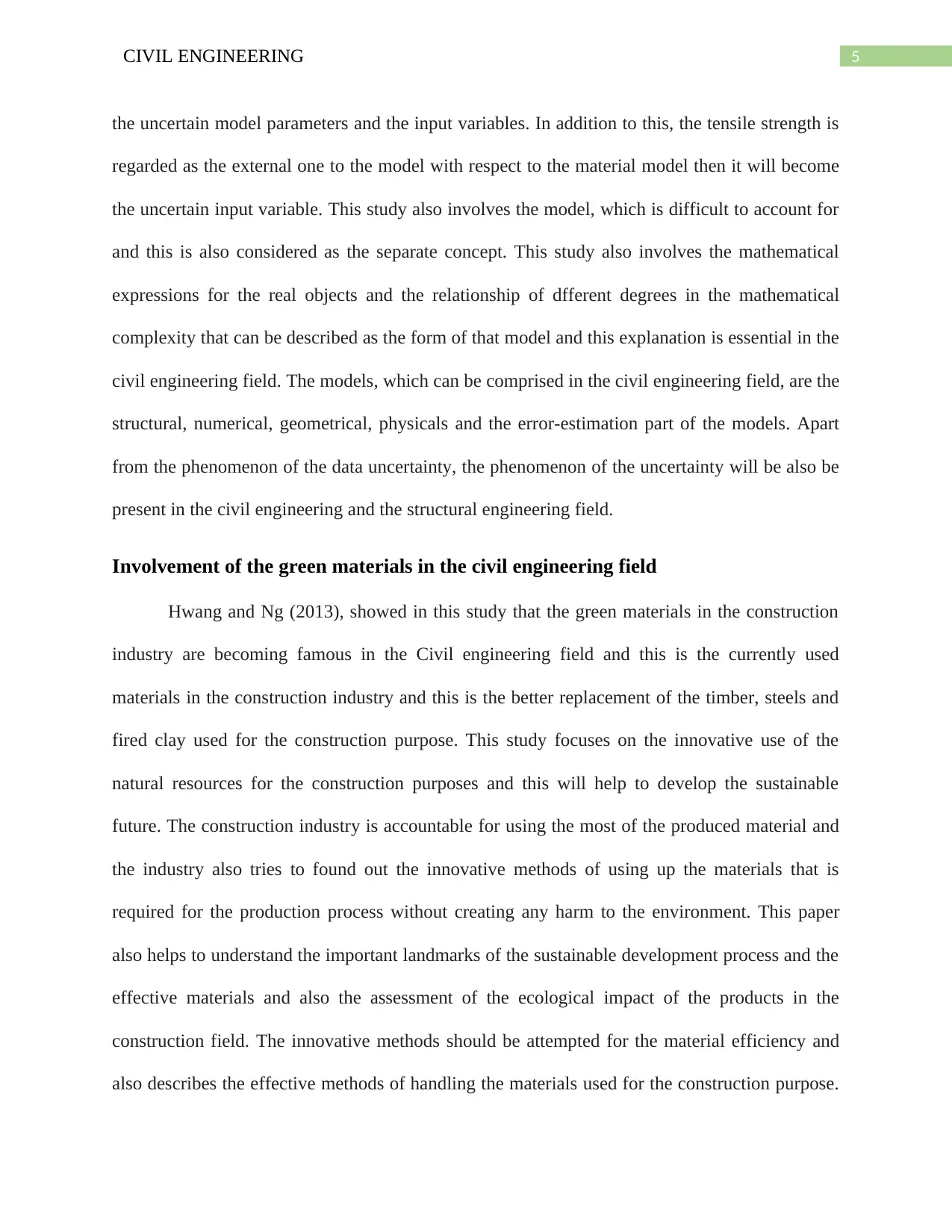
5CIVIL ENGINEERING
the uncertain model parameters and the input variables. In addition to this, the tensile strength is
regarded as the external one to the model with respect to the material model then it will become
the uncertain input variable. This study also involves the model, which is difficult to account for
and this is also considered as the separate concept. This study also involves the mathematical
expressions for the real objects and the relationship of dfferent degrees in the mathematical
complexity that can be described as the form of that model and this explanation is essential in the
civil engineering field. The models, which can be comprised in the civil engineering field, are the
structural, numerical, geometrical, physicals and the error-estimation part of the models. Apart
from the phenomenon of the data uncertainty, the phenomenon of the uncertainty will be also be
present in the civil engineering and the structural engineering field.
Involvement of the green materials in the civil engineering field
Hwang and Ng (2013), showed in this study that the green materials in the construction
industry are becoming famous in the Civil engineering field and this is the currently used
materials in the construction industry and this is the better replacement of the timber, steels and
fired clay used for the construction purpose. This study focuses on the innovative use of the
natural resources for the construction purposes and this will help to develop the sustainable
future. The construction industry is accountable for using the most of the produced material and
the industry also tries to found out the innovative methods of using up the materials that is
required for the production process without creating any harm to the environment. This paper
also helps to understand the important landmarks of the sustainable development process and the
effective materials and also the assessment of the ecological impact of the products in the
construction field. The innovative methods should be attempted for the material efficiency and
also describes the effective methods of handling the materials used for the construction purpose.
the uncertain model parameters and the input variables. In addition to this, the tensile strength is
regarded as the external one to the model with respect to the material model then it will become
the uncertain input variable. This study also involves the model, which is difficult to account for
and this is also considered as the separate concept. This study also involves the mathematical
expressions for the real objects and the relationship of dfferent degrees in the mathematical
complexity that can be described as the form of that model and this explanation is essential in the
civil engineering field. The models, which can be comprised in the civil engineering field, are the
structural, numerical, geometrical, physicals and the error-estimation part of the models. Apart
from the phenomenon of the data uncertainty, the phenomenon of the uncertainty will be also be
present in the civil engineering and the structural engineering field.
Involvement of the green materials in the civil engineering field
Hwang and Ng (2013), showed in this study that the green materials in the construction
industry are becoming famous in the Civil engineering field and this is the currently used
materials in the construction industry and this is the better replacement of the timber, steels and
fired clay used for the construction purpose. This study focuses on the innovative use of the
natural resources for the construction purposes and this will help to develop the sustainable
future. The construction industry is accountable for using the most of the produced material and
the industry also tries to found out the innovative methods of using up the materials that is
required for the production process without creating any harm to the environment. This paper
also helps to understand the important landmarks of the sustainable development process and the
effective materials and also the assessment of the ecological impact of the products in the
construction field. The innovative methods should be attempted for the material efficiency and
also describes the effective methods of handling the materials used for the construction purpose.
⊘ This is a preview!⊘
Do you want full access?
Subscribe today to unlock all pages.

Trusted by 1+ million students worldwide
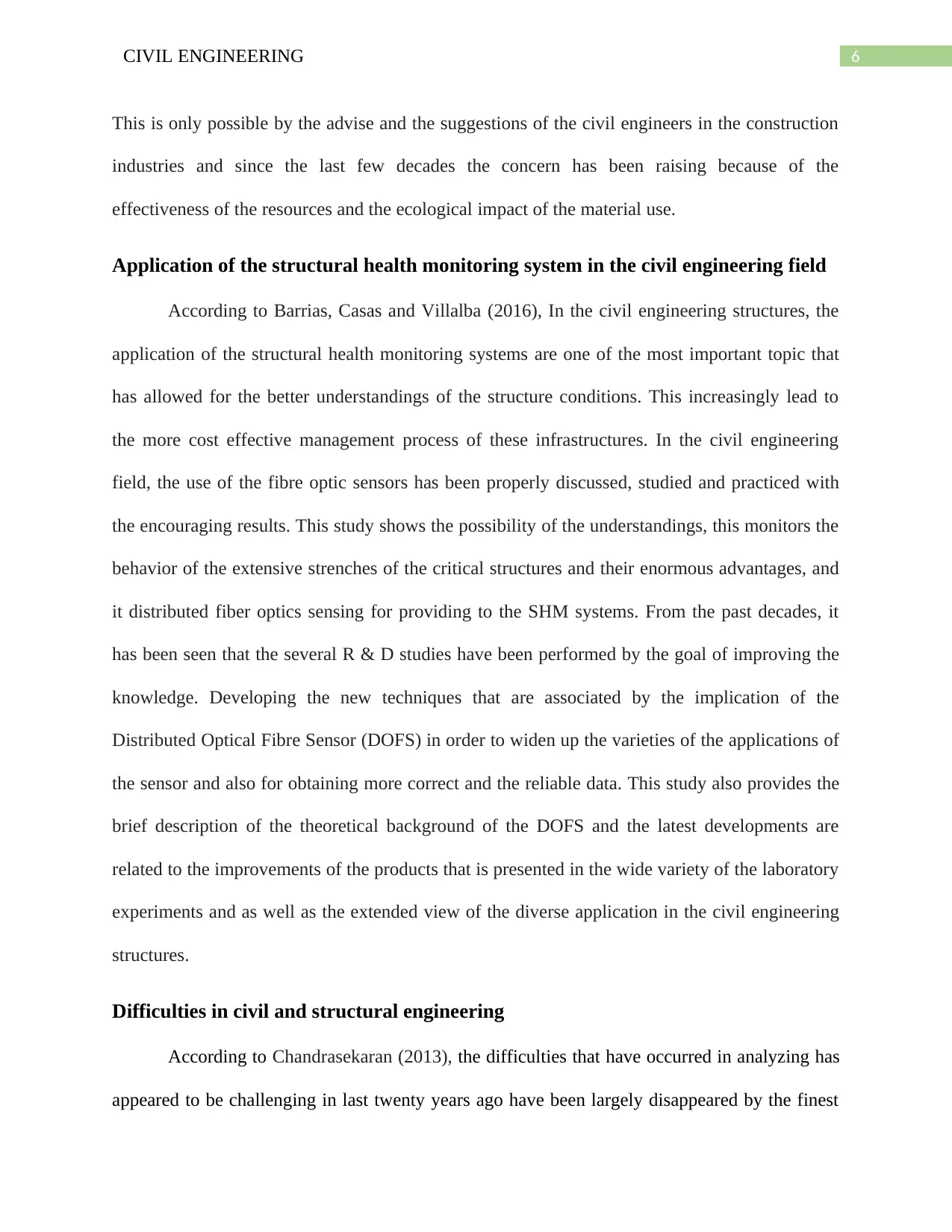
6CIVIL ENGINEERING
This is only possible by the advise and the suggestions of the civil engineers in the construction
industries and since the last few decades the concern has been raising because of the
effectiveness of the resources and the ecological impact of the material use.
Application of the structural health monitoring system in the civil engineering field
According to Barrias, Casas and Villalba (2016), In the civil engineering structures, the
application of the structural health monitoring systems are one of the most important topic that
has allowed for the better understandings of the structure conditions. This increasingly lead to
the more cost effective management process of these infrastructures. In the civil engineering
field, the use of the fibre optic sensors has been properly discussed, studied and practiced with
the encouraging results. This study shows the possibility of the understandings, this monitors the
behavior of the extensive strenches of the critical structures and their enormous advantages, and
it distributed fiber optics sensing for providing to the SHM systems. From the past decades, it
has been seen that the several R & D studies have been performed by the goal of improving the
knowledge. Developing the new techniques that are associated by the implication of the
Distributed Optical Fibre Sensor (DOFS) in order to widen up the varieties of the applications of
the sensor and also for obtaining more correct and the reliable data. This study also provides the
brief description of the theoretical background of the DOFS and the latest developments are
related to the improvements of the products that is presented in the wide variety of the laboratory
experiments and as well as the extended view of the diverse application in the civil engineering
structures.
Difficulties in civil and structural engineering
According to Chandrasekaran (2013), the difficulties that have occurred in analyzing has
appeared to be challenging in last twenty years ago have been largely disappeared by the finest
This is only possible by the advise and the suggestions of the civil engineers in the construction
industries and since the last few decades the concern has been raising because of the
effectiveness of the resources and the ecological impact of the material use.
Application of the structural health monitoring system in the civil engineering field
According to Barrias, Casas and Villalba (2016), In the civil engineering structures, the
application of the structural health monitoring systems are one of the most important topic that
has allowed for the better understandings of the structure conditions. This increasingly lead to
the more cost effective management process of these infrastructures. In the civil engineering
field, the use of the fibre optic sensors has been properly discussed, studied and practiced with
the encouraging results. This study shows the possibility of the understandings, this monitors the
behavior of the extensive strenches of the critical structures and their enormous advantages, and
it distributed fiber optics sensing for providing to the SHM systems. From the past decades, it
has been seen that the several R & D studies have been performed by the goal of improving the
knowledge. Developing the new techniques that are associated by the implication of the
Distributed Optical Fibre Sensor (DOFS) in order to widen up the varieties of the applications of
the sensor and also for obtaining more correct and the reliable data. This study also provides the
brief description of the theoretical background of the DOFS and the latest developments are
related to the improvements of the products that is presented in the wide variety of the laboratory
experiments and as well as the extended view of the diverse application in the civil engineering
structures.
Difficulties in civil and structural engineering
According to Chandrasekaran (2013), the difficulties that have occurred in analyzing has
appeared to be challenging in last twenty years ago have been largely disappeared by the finest
Paraphrase This Document
Need a fresh take? Get an instant paraphrase of this document with our AI Paraphraser

7CIVIL ENGINEERING
elements method that is the increasing introduction of the microcomputers. The engineer today
found out more time to construct and found out the new forms of construction and also found out
the innovative designs for improving the existing designs. Most of the new expertise has been
used to improve the design of ships, aircrafts, offshore platforms, high-rise tower, subway
systems and other. This microcomputer provides those analyses with the greater convenience and
the economy. The engineer today found out more time to construct and found out the new forms
of construction and also found out the innovative designs for improving the existing designs.
This paper involves the internationalism in the engineering sector too along with the designing
method and the more standardized codes and the large computers also provide the technical and
the patent information from all over the world. Most of the new expertise has been used to
improve the design of ships, aircrafts, offshore platforms, high-rise tower, subway systems and
other. The motive of the authors in this study is to recognize the gap between the literatures
involving the innovative theories based on the structural engineering and the structural
mechanics. The earlier construction depends on the rules-of-thumb and the simple code practice.
Fabricated plate grinder in the civil engineering application
According to Ahn et al. (2014), the derivation of the fundamental theory is involved with
the discussion how the theories can be applied in the design. The fabricated plate grinder is
normally used to support the vertical loads over the long spans where the high shearing forces
and the bending moments that developed, those exceeds the capacity of the available hot-rolled
universal beam sections. The longitudinally and the transversely stiffened webs are considered
continued with the attention being paid on the design of the stiffeners themselves and also for the
overall collapse behavior of the grinder. This paper is based on the stability and strength of the
plate girder, this study mainly focuses in maximizing the strength and weight ratio of the plate
elements method that is the increasing introduction of the microcomputers. The engineer today
found out more time to construct and found out the new forms of construction and also found out
the innovative designs for improving the existing designs. Most of the new expertise has been
used to improve the design of ships, aircrafts, offshore platforms, high-rise tower, subway
systems and other. This microcomputer provides those analyses with the greater convenience and
the economy. The engineer today found out more time to construct and found out the new forms
of construction and also found out the innovative designs for improving the existing designs.
This paper involves the internationalism in the engineering sector too along with the designing
method and the more standardized codes and the large computers also provide the technical and
the patent information from all over the world. Most of the new expertise has been used to
improve the design of ships, aircrafts, offshore platforms, high-rise tower, subway systems and
other. The motive of the authors in this study is to recognize the gap between the literatures
involving the innovative theories based on the structural engineering and the structural
mechanics. The earlier construction depends on the rules-of-thumb and the simple code practice.
Fabricated plate grinder in the civil engineering application
According to Ahn et al. (2014), the derivation of the fundamental theory is involved with
the discussion how the theories can be applied in the design. The fabricated plate grinder is
normally used to support the vertical loads over the long spans where the high shearing forces
and the bending moments that developed, those exceeds the capacity of the available hot-rolled
universal beam sections. The longitudinally and the transversely stiffened webs are considered
continued with the attention being paid on the design of the stiffeners themselves and also for the
overall collapse behavior of the grinder. This paper is based on the stability and strength of the
plate girder, this study mainly focuses in maximizing the strength and weight ratio of the plate
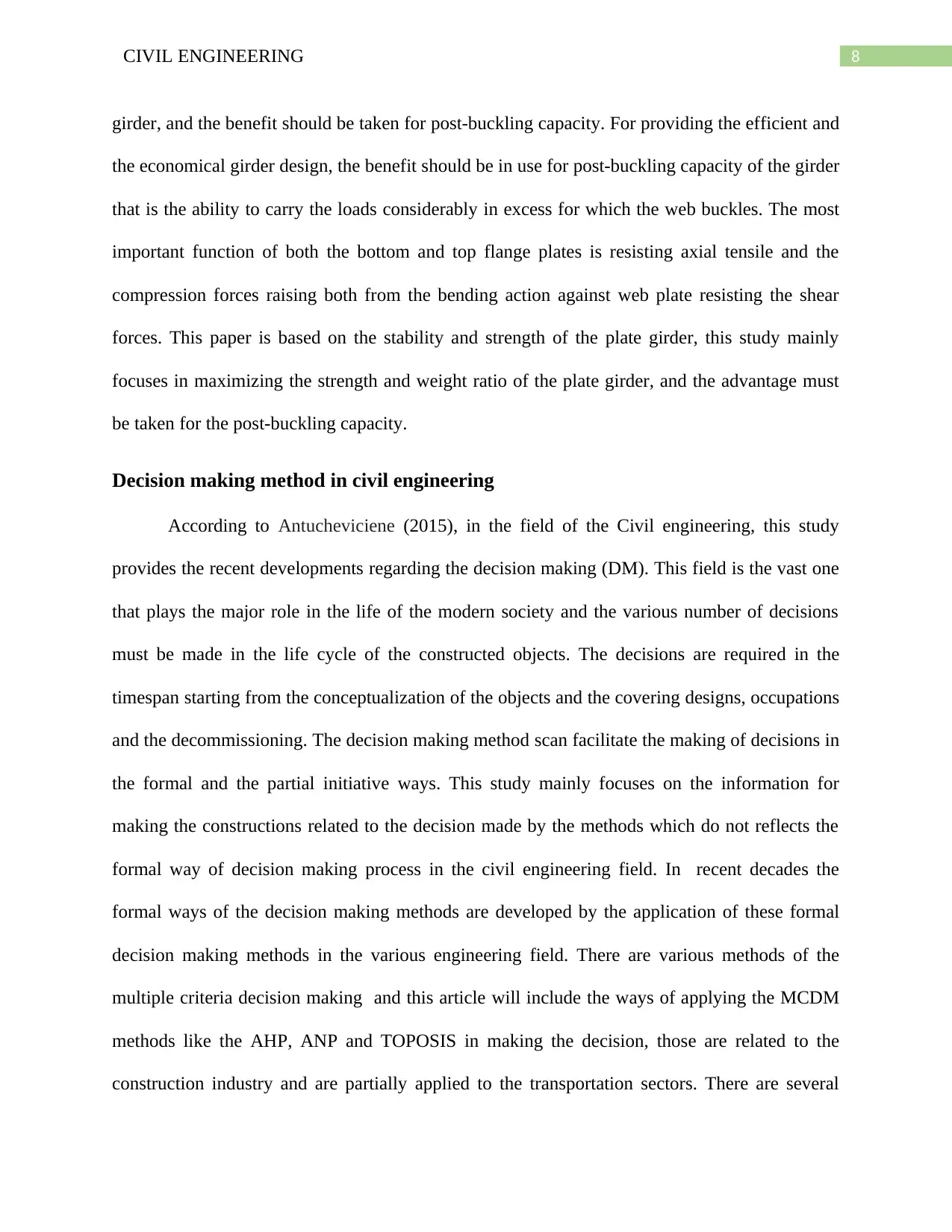
8CIVIL ENGINEERING
girder, and the benefit should be taken for post-buckling capacity. For providing the efficient and
the economical girder design, the benefit should be in use for post-buckling capacity of the girder
that is the ability to carry the loads considerably in excess for which the web buckles. The most
important function of both the bottom and top flange plates is resisting axial tensile and the
compression forces raising both from the bending action against web plate resisting the shear
forces. This paper is based on the stability and strength of the plate girder, this study mainly
focuses in maximizing the strength and weight ratio of the plate girder, and the advantage must
be taken for the post-buckling capacity.
Decision making method in civil engineering
According to Antucheviciene (2015), in the field of the Civil engineering, this study
provides the recent developments regarding the decision making (DM). This field is the vast one
that plays the major role in the life of the modern society and the various number of decisions
must be made in the life cycle of the constructed objects. The decisions are required in the
timespan starting from the conceptualization of the objects and the covering designs, occupations
and the decommissioning. The decision making method scan facilitate the making of decisions in
the formal and the partial initiative ways. This study mainly focuses on the information for
making the constructions related to the decision made by the methods which do not reflects the
formal way of decision making process in the civil engineering field. In recent decades the
formal ways of the decision making methods are developed by the application of these formal
decision making methods in the various engineering field. There are various methods of the
multiple criteria decision making and this article will include the ways of applying the MCDM
methods like the AHP, ANP and TOPOSIS in making the decision, those are related to the
construction industry and are partially applied to the transportation sectors. There are several
girder, and the benefit should be taken for post-buckling capacity. For providing the efficient and
the economical girder design, the benefit should be in use for post-buckling capacity of the girder
that is the ability to carry the loads considerably in excess for which the web buckles. The most
important function of both the bottom and top flange plates is resisting axial tensile and the
compression forces raising both from the bending action against web plate resisting the shear
forces. This paper is based on the stability and strength of the plate girder, this study mainly
focuses in maximizing the strength and weight ratio of the plate girder, and the advantage must
be taken for the post-buckling capacity.
Decision making method in civil engineering
According to Antucheviciene (2015), in the field of the Civil engineering, this study
provides the recent developments regarding the decision making (DM). This field is the vast one
that plays the major role in the life of the modern society and the various number of decisions
must be made in the life cycle of the constructed objects. The decisions are required in the
timespan starting from the conceptualization of the objects and the covering designs, occupations
and the decommissioning. The decision making method scan facilitate the making of decisions in
the formal and the partial initiative ways. This study mainly focuses on the information for
making the constructions related to the decision made by the methods which do not reflects the
formal way of decision making process in the civil engineering field. In recent decades the
formal ways of the decision making methods are developed by the application of these formal
decision making methods in the various engineering field. There are various methods of the
multiple criteria decision making and this article will include the ways of applying the MCDM
methods like the AHP, ANP and TOPOSIS in making the decision, those are related to the
construction industry and are partially applied to the transportation sectors. There are several
⊘ This is a preview!⊘
Do you want full access?
Subscribe today to unlock all pages.

Trusted by 1+ million students worldwide
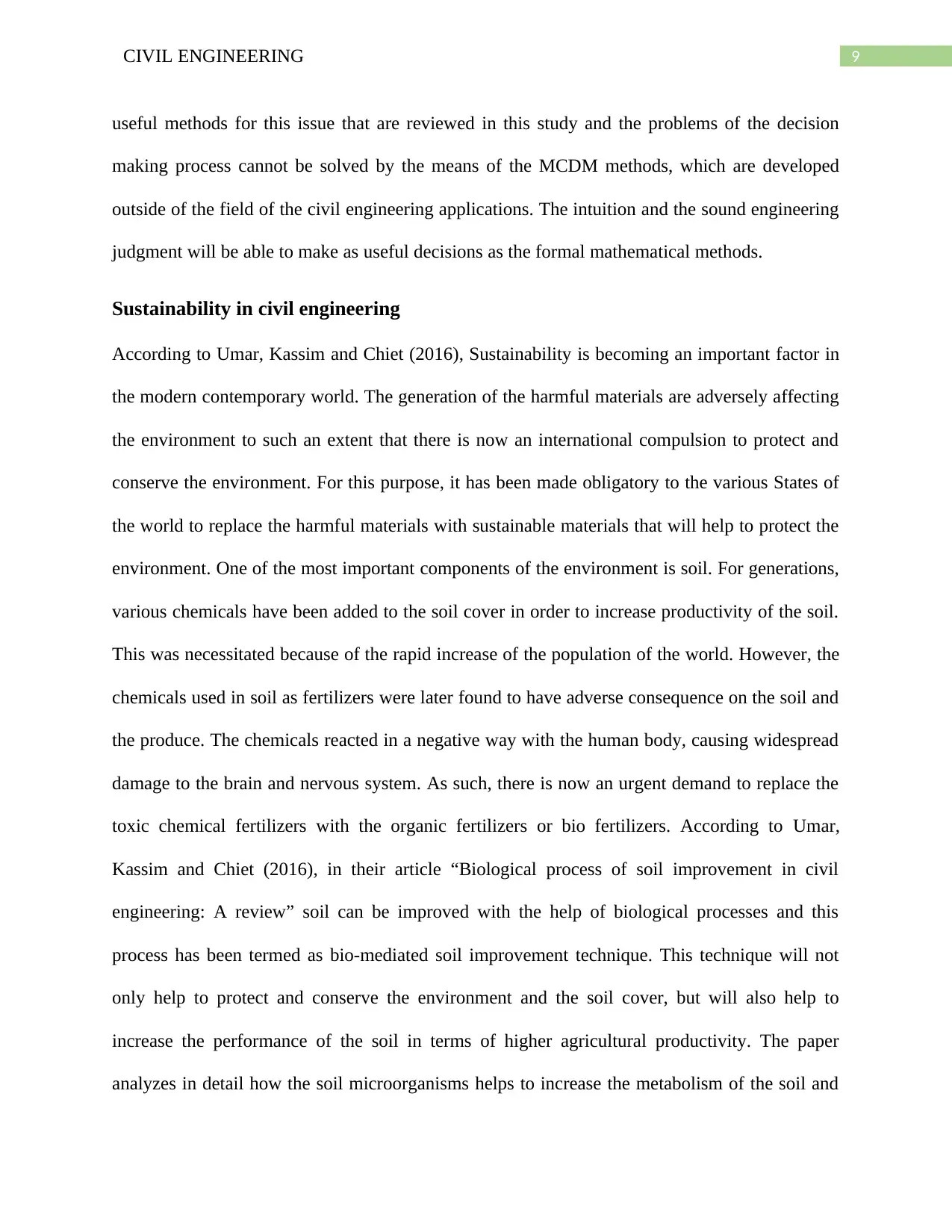
9CIVIL ENGINEERING
useful methods for this issue that are reviewed in this study and the problems of the decision
making process cannot be solved by the means of the MCDM methods, which are developed
outside of the field of the civil engineering applications. The intuition and the sound engineering
judgment will be able to make as useful decisions as the formal mathematical methods.
Sustainability in civil engineering
According to Umar, Kassim and Chiet (2016), Sustainability is becoming an important factor in
the modern contemporary world. The generation of the harmful materials are adversely affecting
the environment to such an extent that there is now an international compulsion to protect and
conserve the environment. For this purpose, it has been made obligatory to the various States of
the world to replace the harmful materials with sustainable materials that will help to protect the
environment. One of the most important components of the environment is soil. For generations,
various chemicals have been added to the soil cover in order to increase productivity of the soil.
This was necessitated because of the rapid increase of the population of the world. However, the
chemicals used in soil as fertilizers were later found to have adverse consequence on the soil and
the produce. The chemicals reacted in a negative way with the human body, causing widespread
damage to the brain and nervous system. As such, there is now an urgent demand to replace the
toxic chemical fertilizers with the organic fertilizers or bio fertilizers. According to Umar,
Kassim and Chiet (2016), in their article “Biological process of soil improvement in civil
engineering: A review” soil can be improved with the help of biological processes and this
process has been termed as bio-mediated soil improvement technique. This technique will not
only help to protect and conserve the environment and the soil cover, but will also help to
increase the performance of the soil in terms of higher agricultural productivity. The paper
analyzes in detail how the soil microorganisms helps to increase the metabolism of the soil and
useful methods for this issue that are reviewed in this study and the problems of the decision
making process cannot be solved by the means of the MCDM methods, which are developed
outside of the field of the civil engineering applications. The intuition and the sound engineering
judgment will be able to make as useful decisions as the formal mathematical methods.
Sustainability in civil engineering
According to Umar, Kassim and Chiet (2016), Sustainability is becoming an important factor in
the modern contemporary world. The generation of the harmful materials are adversely affecting
the environment to such an extent that there is now an international compulsion to protect and
conserve the environment. For this purpose, it has been made obligatory to the various States of
the world to replace the harmful materials with sustainable materials that will help to protect the
environment. One of the most important components of the environment is soil. For generations,
various chemicals have been added to the soil cover in order to increase productivity of the soil.
This was necessitated because of the rapid increase of the population of the world. However, the
chemicals used in soil as fertilizers were later found to have adverse consequence on the soil and
the produce. The chemicals reacted in a negative way with the human body, causing widespread
damage to the brain and nervous system. As such, there is now an urgent demand to replace the
toxic chemical fertilizers with the organic fertilizers or bio fertilizers. According to Umar,
Kassim and Chiet (2016), in their article “Biological process of soil improvement in civil
engineering: A review” soil can be improved with the help of biological processes and this
process has been termed as bio-mediated soil improvement technique. This technique will not
only help to protect and conserve the environment and the soil cover, but will also help to
increase the performance of the soil in terms of higher agricultural productivity. The paper
analyzes in detail how the soil microorganisms helps to increase the metabolism of the soil and
Paraphrase This Document
Need a fresh take? Get an instant paraphrase of this document with our AI Paraphraser

10CIVIL ENGINEERING
makes the soil particles conducive for easy production. The concept of bio mineralization has
also been discussed in the paper which is a revolutionizing concept of how mineralization is
done with the help of biological factors rather than taking the help of harmful chemicals.
makes the soil particles conducive for easy production. The concept of bio mineralization has
also been discussed in the paper which is a revolutionizing concept of how mineralization is
done with the help of biological factors rather than taking the help of harmful chemicals.
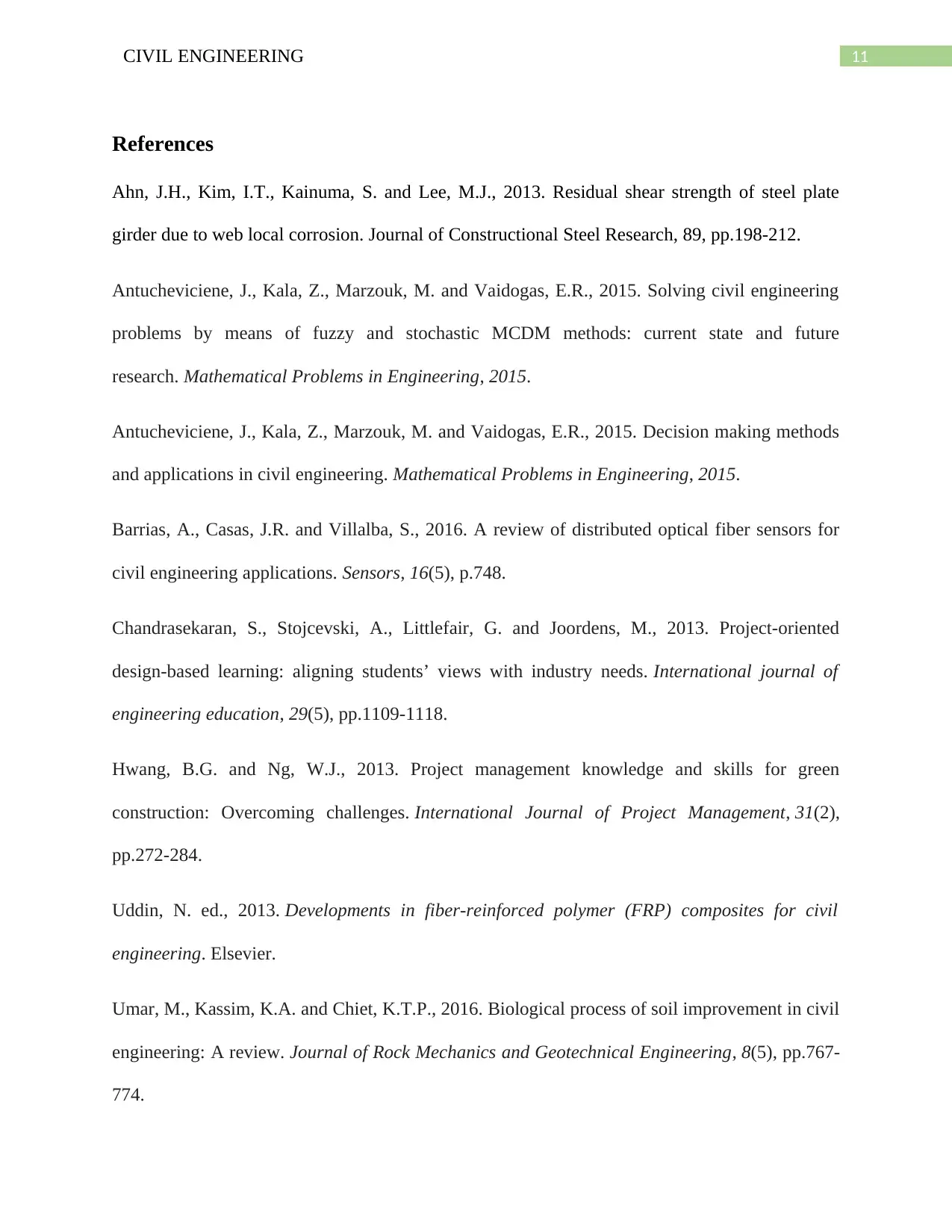
11CIVIL ENGINEERING
References
Ahn, J.H., Kim, I.T., Kainuma, S. and Lee, M.J., 2013. Residual shear strength of steel plate
girder due to web local corrosion. Journal of Constructional Steel Research, 89, pp.198-212.
Antucheviciene, J., Kala, Z., Marzouk, M. and Vaidogas, E.R., 2015. Solving civil engineering
problems by means of fuzzy and stochastic MCDM methods: current state and future
research. Mathematical Problems in Engineering, 2015.
Antucheviciene, J., Kala, Z., Marzouk, M. and Vaidogas, E.R., 2015. Decision making methods
and applications in civil engineering. Mathematical Problems in Engineering, 2015.
Barrias, A., Casas, J.R. and Villalba, S., 2016. A review of distributed optical fiber sensors for
civil engineering applications. Sensors, 16(5), p.748.
Chandrasekaran, S., Stojcevski, A., Littlefair, G. and Joordens, M., 2013. Project-oriented
design-based learning: aligning students’ views with industry needs. International journal of
engineering education, 29(5), pp.1109-1118.
Hwang, B.G. and Ng, W.J., 2013. Project management knowledge and skills for green
construction: Overcoming challenges. International Journal of Project Management, 31(2),
pp.272-284.
Uddin, N. ed., 2013. Developments in fiber-reinforced polymer (FRP) composites for civil
engineering. Elsevier.
Umar, M., Kassim, K.A. and Chiet, K.T.P., 2016. Biological process of soil improvement in civil
engineering: A review. Journal of Rock Mechanics and Geotechnical Engineering, 8(5), pp.767-
774.
References
Ahn, J.H., Kim, I.T., Kainuma, S. and Lee, M.J., 2013. Residual shear strength of steel plate
girder due to web local corrosion. Journal of Constructional Steel Research, 89, pp.198-212.
Antucheviciene, J., Kala, Z., Marzouk, M. and Vaidogas, E.R., 2015. Solving civil engineering
problems by means of fuzzy and stochastic MCDM methods: current state and future
research. Mathematical Problems in Engineering, 2015.
Antucheviciene, J., Kala, Z., Marzouk, M. and Vaidogas, E.R., 2015. Decision making methods
and applications in civil engineering. Mathematical Problems in Engineering, 2015.
Barrias, A., Casas, J.R. and Villalba, S., 2016. A review of distributed optical fiber sensors for
civil engineering applications. Sensors, 16(5), p.748.
Chandrasekaran, S., Stojcevski, A., Littlefair, G. and Joordens, M., 2013. Project-oriented
design-based learning: aligning students’ views with industry needs. International journal of
engineering education, 29(5), pp.1109-1118.
Hwang, B.G. and Ng, W.J., 2013. Project management knowledge and skills for green
construction: Overcoming challenges. International Journal of Project Management, 31(2),
pp.272-284.
Uddin, N. ed., 2013. Developments in fiber-reinforced polymer (FRP) composites for civil
engineering. Elsevier.
Umar, M., Kassim, K.A. and Chiet, K.T.P., 2016. Biological process of soil improvement in civil
engineering: A review. Journal of Rock Mechanics and Geotechnical Engineering, 8(5), pp.767-
774.
⊘ This is a preview!⊘
Do you want full access?
Subscribe today to unlock all pages.

Trusted by 1+ million students worldwide
1 out of 13
Your All-in-One AI-Powered Toolkit for Academic Success.
+13062052269
info@desklib.com
Available 24*7 on WhatsApp / Email
![[object Object]](/_next/static/media/star-bottom.7253800d.svg)
Unlock your academic potential
Copyright © 2020–2025 A2Z Services. All Rights Reserved. Developed and managed by ZUCOL.

